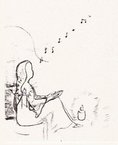Be Still
Be Still is a space to explore different dimensions of prayer and meditation, meeting on the 2nd Monday of each month
The next session is:
Monday 8th April 8pm - 9pm
Margaret Leeke will lead a session on the Pearls of Life
All Welcome.
The next session is:
Monday 8th April 8pm - 9pm
Margaret Leeke will lead a session on the Pearls of Life
All Welcome.
SOME HELPS FOR STILLNESS
Be still and know that I am God. Psalm 46:10
| |||||||
what is prayer?
|

To pray is to sit Open-handed before God. Peter G. van Breeman | ||||||
THE ART OF LECTIO DIVINA
| lectio_divina.pdf | |
| File Size: | 400 kb |
| File Type: | |
|
Lectio Divina is a Latin term, which roughly translates as ‘Divine Reading’. It invites us to chew, savour and mull over God's words quietly, slowly and intently. It can be used individually or in a group setting.
Lectio traditionally has a four-step approach: · Reading Lectio · Meditation Meditatio · Prayer Oratio · Contemplation Contemplatio |
imaginative contemplation
| imaginative_contemplation.pdf | |
| File Size: | 125 kb |
| File Type: | |


